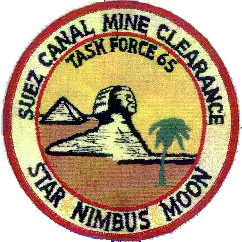Operation Nimbus Moon (Water)
Operation Moon Water was the clearance of ordnance from the Suez Canal bed as part of Operation Nimbus Moon. The operation ran until the end of 1974 and, at a much-reduced rate, into 1975, being completed by the end of July 1975. U.S. Navy EOD divers, who were prohibited from actual ordnance operations, provided both diving and explosives training to Egyptian Navy personnel and accompanied them in the diving boats, serving as on-scene advisors. A Suez Canal Authority pilot boat with an American sonar device installed searched the canal from bank to bank providing highly accurate charts of the canal bed. These charts were used by the diving advisors, who directed the Egyptians to investigate likely ordnance contacts. The ordnance that was discovered was usually destroyed in place with explosive charges. Non-ordnance items, such as oil drums or tanks, were marked for later removal by Egyptian police divers because the canal was slated for future dredging, all large pieces of refuse had to be removed. [4] [5] The American-Egyptian team completed one full sweep of the canal bottom in late November 1974.
British and French EOD divers were also conducting their own searches. Through double-sweeping and, at times, triple-sweeping various areas, more complete coverage could be obtained. Each group found items missed by previous divers. The Royal Navy used three mine-hunting ships, with their high-resolution sonar equipment, and an independent diving group known as the Fleet Clearance Diving Team. The French Navy used both mine-hunting ships in an active role and minesweepers as support ships.
When the search operations covered by Moon Water were finished in December 1974, a large amount of ordnance had been discovered: [4]
- Approximately 7,500 unexploded ordnance items were found within the canal proper. They included about 375 rockets, 450 anti-tank mines, 600 projectiles, 825 mortars, 825 anti-personnel mines, a small number of bombs and over 1,100 bomblets, plus miscellaneous items such as grenades, scare charges, demolition charges, unit lots of small ammunition, and one 200 pound (90 kg) German air dropped mine from World War II.
- More than 1,000 unexploded ordnance items were found in harbors, basins, and anchorages outside of the canal. They consisted of a large number of miscellaneous items and, in smaller numbers, anti-tank mines, anti-personnel mines, rockets, mortars, projectiles (75 mm) and bomblets.
- Approximately 700 non-ordnance items were found, including 392 items inside the canal proper and 296 items in harbor basins and anchorages. 118 pontoon bridge sections, 102 boats and barges, and numerous large anchors, oil drums, trucks, tanks, aircraft wreckage, and other vehicles were among the items found.



